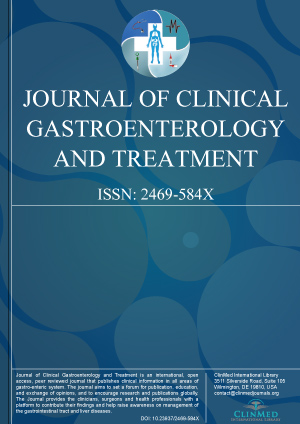Open Access DOI:10.23937/2469-584X/1510008
Validation of Steroid-Free Immunosuppression Regimen after Liver Transplantation
Ken Fukumitsu, Ahmed Hammad, Toshimi Kaido, Kohei Ogawa, Yasuhiro Fujimoto, Akira Mori, Hideaki Okajima and Shinji Uemoto
Article Type: Original Article | First Published: November 27, 2015
Liver transplantation (LT) is performed worldwide with immunosuppression being an indispensable component of the perioperative management. Calcineurin inhibitors and steroids have been the most popular and widely used drugs for a long time. However, steroids hold long-term adverse effects, as increased susceptibility to infection, hyperglycemia, hyperlipidemia, obesity, hypertension and osteopenia. Furthermore, steroids have been implicated in hepatitis C (HCV) recurrence after LT and graft fail...
Open Access DOI:10.23937/2469-584X/1510007
Buried Balloon: A Novel Complication from Percutaneous Radiologic Gastrostomy Tube Placement
Meghana Vellanki, Steve B Clayton and Patrick Brady
Article Type: Case Series | First Published: November 16, 2015
Gastrostomy tube (G-tube) placement, once a staple of surgeons and gastroenterologists, has propagated into other fields of medicine with interventional radiology (IR) performing percutaneous radiologic gastrostomy (PRG). With more G-tubes being placed by IR, there have been novel complications associated with this technique. In the following case series, we describe one complication as a result of PRG tube placement by IR, called the 'Buried Balloon'....
Open Access DOI:10.23937/2469-584X/1510006
Impairment of Salivary Protection in Esophageal Defense: Its Implications in Reflux Esophagitis
Harathi Yandrapu, Marek Marcinkiewicz, Tomasz Zbroch, Cezary Poplawski, Irene Sarosiek, Zbigniew Namiot and Jerzy Sarosiek
Article Type: Original Article | First Published: September 28, 2015
Gastroesophageal Reflux Disease (GERD) is a highly prevalent disease in the western world and affects approximately up to 20% of adults and nearly 25 million experience heartburn on a daily basis. Reflux esophagitis (RE) is caused by the excessive exposure of esophageal mucosa to aggressive factors like acid and pepsin leading to inflammation. Gastroesophageal reflux is a common phenomenon which would not normally cause esophageal mucosal damage because of presence of defense mechanisms....
Open Access DOI:10.23937/2469-584X/1510005
'Endoscopic Exposure Treatment' for a Small Colonic Lipoma
Toshiro Fukui
Article Type: Clinical Image | First Published: September 25, 2015
Lipomas form lobulated masses enclosed by thin and fibrous capsules. Colonic lipomas are usually discovered on colonoscopy, and gentle palpation with biopsy forceps reveals soft nature of the submucosal mass. Submucosal lipomas are usually not fixed to the underlying fascia. Large colonic ones may manifest as luminal obstruction, intussusception, volvulization or hemorrhage. Nonsurgical therapy includes endoscopic treatment for submucosal tumors in gastrointestinal tracts. In particular, the unr...
Open Access DOI:10.23937/2469-584X/1510004
Hormonal Therapy for GI Angiodysplasia: Out of Hope After Failure of the Scope?
Ujjwal Kumar, Kevin Cowley and Frederick Weber
Article Type: Case Report | First Published: September 14, 2015
Angiodysplasia of the gastrointestinal (GI) tract can present both diagnostic and therapeutic challenges. Despite the recent advances in endoscopy, many patients continue to suffer from recurrent bleeding. We report a remarkable case of a multi-year history of transfusion-requiring obscure overt recurrent GI bleeding, refractory to multiple endoscopic therapies as well as both octreotide and thalidomide. Upon initiation of hormonal therapy, the patient's bleeding completely resolved, with comple...
Open Access DOI:10.23937/2469-584X/1510003
Effect of Biologics on the Outcomes of Inflammatory Bowel Disease: A Retrospective Study on a Large Pediatric Cohort
Hoda M. Malatyr, Bincy Abraham, Mina S. Emil, George D. Ferry and Elizabeth A. Garnett
Article Type: Research Article | First Published: September 11, 2015
The incidence of inflammatory bowel disease (IBD) in children has increased over the past 20 years and treatment with biologics is increasingly used.
Objective: We assessed the associations of biologics to IBD outcomes in children.
Methods: A retrospective investigation was conducted on a cohort of children with IBD between 1988/2008 who were enrolled in the Pediatric IBD registry. The diagnosis of IBD was based on clinical, radiological, endoscopic, and/or histological examinations. Clini...
Open Access DOI:10.23937/2469-584X/1510001
Expectations for Hepatitis B Universal Vaccination for Hepatitis B Virus Eradication
Toru Ishikawa
Article Type: Review Article | First Published: August 26, 2015
The incidence of hepatitis B virus (HBV)-related HCC has not declined for the past several decades. HBV is essentially a disease that could potentially be eradicated by a vaccine. According to the World Health Organization (WHO), two billion people (one-third of the global population) have been infected with HBV worldwide, and more than 240 million are chronic carriers (4-6% of the world population)....

